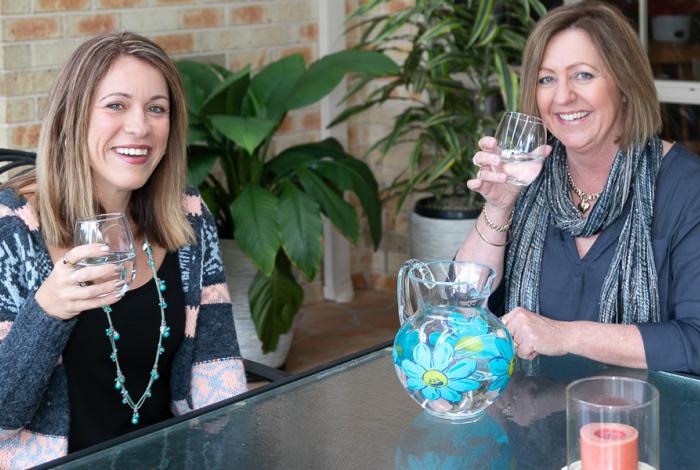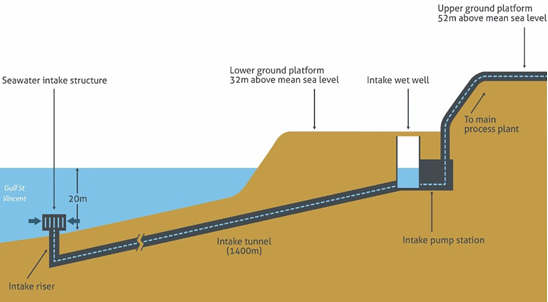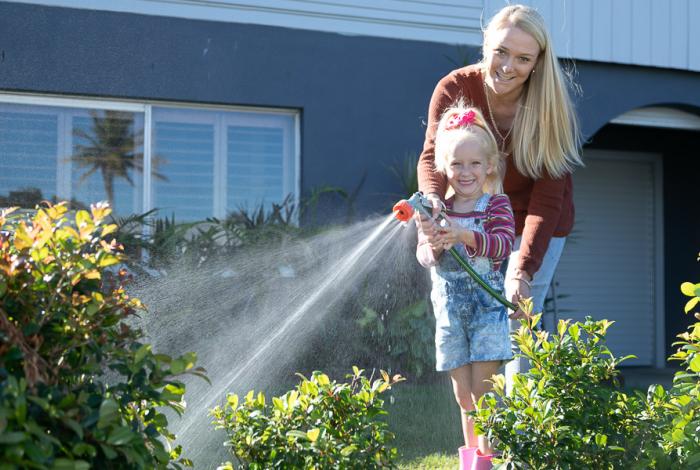Council is seeking to modify the existing planning approval for the possible construction of a drought response desalination plant adjacent to Toukley Sewage Treatment Plant (STP). This will involve amending the existing DA which includes an intake structure on Budgewoi Beach to a direct ocean intake structure off the coast between Jenny Dixon Beach, Noraville and Pelican Point Beach, Magenta. This is our insurance policy in case of unprecedented drought conditions.
From 8 February and 7 March 2021, Council sought community feedback on plans to modify the development assessment for the drought response desalination plant at Toukley.
The community are invited to:
- View the Draft Drought Response Desalination Plant Project Summary
- View the Frequently Asked Questions available below
Background information
Council has been developing a project to implement drought response infrastructure in the form of a desalination plant on the Coast for many years. Studies since 2005 have supported the construction of a desalination plant and associated infrastructure adjacent to the existing Toukley Sewage Treatment Plant.
The initial proposed location of the intake structure for the plant was on Budgewoi Beach utilising a horizontal collector well intake design. A constructability assessment of this proposed model revealed a number of potential risks and associated construction challenges. As a result, this model and intake structure is not favoured.
The preferred model would utilise a conventional direct ocean intake located approximately 1000m off the coast, between Jenny Dixon Beach, Noraville and Pelican Point Beach, Magenta. Using this known and proven technology would pose fewer construction challenges and would result in significantly lower costs to construct.
In order to modify the existing planning approval, undertaking a series of studies including intake location, water quality, marine monitoring, marine hazard, ecology impact assessment and EIS documentation.
Document Library
What is this project about?
Council is seeking to modify the existing NSW Government planning approval for the future construction of a drought response desalination plant. The plant will consist of a direct ocean intake located between Jenny Dixon Beach, Noraville and Pelican Point Beach, Magenta (exact location to be established following further studies), a Reverse Osmosis (RO) desalination plant adjacent to the existing Toukley Sewage Treatment Plant (STP) discharging brine to the existing Norah Head Sewage Ocean Outfall and delivering up to 30 Megalitres per day of drinking water directly into the existing water reticulation network. This is our insurance policy in case of unprecedented drought conditions and our surface water storages decline to critically low levels.
What is a 'drought response' desalination plant?
Its unacceptable for the Central Coast to ever run out of water. During a severe drought our storage levels could deplete to a level that requires us to take action to manage the risk of running out of water. This would involve the construction of a drought response desalination plant to produce additional drinking water when dam levels reach critical levels.
What is the difference between a drought response desalination plant and a long-term water supply desalination plant?
The design of any drought response desalination plant would ensure that the asset could be integrated into Council’s broader water supply network for future usage when dam levels drop in the future. During times of high dam levels the plant would not need to run, with the plant then operated when storage levels drop. This would be similar to the operation of the Sydney desalination plant.
The preferred options to meet future water demands on the Central Coast are currently being assessed by Council’s Integrated Water Resource Plan. To have your say on the options being considered within that plan please visit the Integrated Water Resource Plan page.
Why is this considered the best option to address future potential drought conditions?
Desalination is identified as a later step, within a range of measures contained in Council’s Drought Management Plan.
Additional water sources introduced as part of managing a severe drought need to be highly reliable and independent of rainfall to provide the required volume of drinking water.
Desalination is the preferred technology to meet these outcomes for coastal communities across Australia.
What will the project cost?
The cost of this stage of the project to modify the existing Development Application will be approximately $1.3M. This will cover the cost of modifying the existing approved State Govt Development Application (DA) and preparing a number of studies/investigations including the following to determine the concept design:
- Environmental Impact Statement (EIS) / Statement of Environmental Effects (SEE) – to be updated
- Intake location study
- Geotechnical investigation
- Hydrodynamic modelling survey
- Cultural heritage study
- Maritime hazard study
- Risks and impact assessment
The estimated total cost of construction for the desalination project will be determined following the completion of the additional concept design activities.
How will the plant be funded?
The total cost of the desalination project will be determined when construction is triggered and could be funded through a combination of Federal and State Government grants along with provision through future IPART determinations.
When will it be built?
The desalination plant will only be built if our surface water storage volumes decline to low levels during an extended drought period. However, Council is undertaking the pre-construction activities now so that all planning approvals are in place should we need to construct the plant.
Why are you waiting to build it?
The odds of switching on the plant are very low but we won’t take the chance of running out of water because planning approvals were not in place. Gaining approvals now means we’re ready for the worst and can construct the plant relatively quickly should it be required.
By saving water in our own system and working in partnership with our community and local businesses to reduce demand, we’re allowing time for new technologies to emerge which will make for a smarter, more sustainable water future.
How long will it take to build?
By undertaking the pre-construction activities now, we can shorten the anticipated construction period to less than 30 months.
Why was this location chosen?
Council have been developing a project to implement drought response infrastructure in the form of a desalination plant on the Coast for many years. Studies since 2005 have supported the construction of a desalination plant and associated infrastructure adjacent to the existing Toukley Sewage Treatment Plant (STP). The initial proposed location for the Intake Structure for the plant was on Budgewoi Beach utilising a horizontal collector well intake design.
A constructability assessment of this proposed model revealed a number of potential risks and construction challenges. As a result, this model and intake structure is not favoured.
The preferred model would utilise conventional direct ocean intake using known and proven technology, would pose less construction challenges and would result in significantly lower costs to construct.
How does direct ocean intake work?
A subsurface tunnel is constructed using horizontal drilling techniques from the shore to a distance approximately 1km from the shoreline. Divers would connect an intake riser to the tunnel in approximately 20metres depth of water.
This tunnel would allow seawater to flow (at low velocity) to the pumping station which would then transfer the water to the pre-treatment facility.
How much of the plant and associated structures will we see when its finished?
The desalination plant will be constructed on Council owned land adjacent to the existing Toukley STP (off Wilfred Barrett Drive). It is anticipated that plant will not be able to be seen from the road.
Will the plant be noisy?
A Noise Impact Assessment was undertaken as part of the original Statement of Environmental Effects (SEE) in 2005, which identified noise impacts during construction which would be mitigated by appropriate controls.
Minimal operational noise may be generated from the distribution pumps and post-treatment building. However, design considerations and the use of appropriate insulation of the post-treatment building will reduce potential noise emissions to low levels.
What hours will it operate?
The operating configuration is yet to be determined and will be considered as part of the construction phase of the project.
How much drinking water will it produce?
The proposed desalination plant could produce up to 30 Megalitres per day. This would be enough to slow the depletion of water from our main water sources but would still represent only a proportion of our overall water supply.
Will the operation of the plant to produce drinking water impact water pricing for customers?
The Independent Pricing and Regulatory Tribunal (IPART) determines Central Coast Council’s water revenues and prices during periodic reviews. Any impact to customer prices would be determined by IPART if the project proceeds.
How does desalination work?
Desalination is the process of removing dissolved salts and other particles from seawater.
1. Seawater Intake – Seawater from the ocean enters an intake pipeline through a low-velocity intake structure located above the seafloor about 1km offshore. The seawater flows along the intake pipeline to the seawater intake pump station located on shore.
2. Pre-treatment – Water is then pumped from the seawater intake pump station to the pre-treatment facility, where coarse filters are used to remove larger particles. The seawater is then filtered through ultra-fine membranes to remove smaller particles.
3. Reverse osmosis (RO) – The cleaner seawater is then forced at high pressure through thousands of reverse osmosis membranes, which act as very fine filters, to remove dissolved salts and other particles. Fresh water is extracted and seawater concentrate is left behind. Approximately 42 per cent of the seawater becomes drinking water.
4. Final treatment – The fresh water is treated to meet Australian Drinking Water Guidelines and fluoride is added to protect teeth. The drinking water then travels through pipelines to join the Central Coast supply network.
5. Seawater concentrate (Brine) – The remaining seawater concentrate is about twice as salty and about one degree warmer than the ocean. It would be pumped to Toukley Sewage Treatment Plant before transfer to Norah Head Ocean Outfall where it would be returned, along with wastewater effluent, through a large pipe that lies beneath the seabed. The effluent and seawater concentrate is dispersed using specially designed diffusers which return the seawater concentrate to normal salinity and temperature.
How much energy does desalination use?
Desalination does use more energy than sourcing water using traditional methods, such as gravity feeding water out of a dam.
We should remember that desalinated water is not reliant on rainfall so in a prolonged drought it would be our emergency measure.
It takes approximately the same amount of power to run a modern fridge for one day as it does to produce enough desalinated water for the daily use of a family of four.
What happens to the salt from seawater?
During the desalination process, freshwater is extracted from seawater and brine is returned to the environment.
Desalination plants need to meet stringent environmental protection criteria. They’re designed to have minimal impact on the surrounding environment.
What is the impact on the environment?
Council places a high priority on minimising any environmental impacts - both on land and in the water.
Additional environmental assessments will be undertaken as part of the revised direct ocean intake works, which includes various marine studies and land-based assessments which together will form part of the updated Environmental Impact Statement (EIS) documentation.
How does the desalinated water taste?
Like water sourced from a dam and treated at a water treatment plant, water from a desalination plant would be treated to meet the Australian Drinking Water Guidelines, which includes criteria for the aesthetic quality of drinking water in addition to criteria for the protection of public health.


